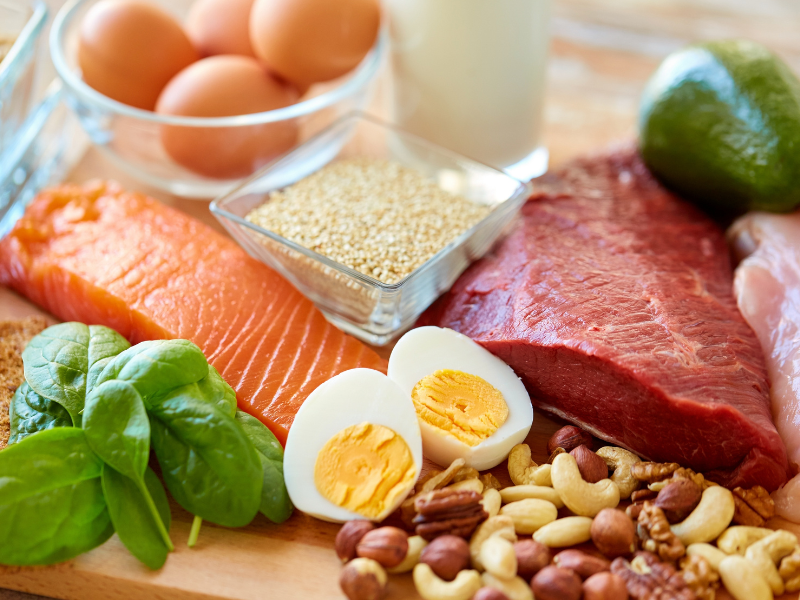Body recomposition for women offers a unique approach to transforming the physique by simultaneously losing fat and gaining muscle. This process requires a balanced diet rich in protein, strength training, and calorie cycling, with tracking metrics like body fat percentage and muscle growth being essential. By monitoring progress and adjusting plans accordingly, women can achieve remarkable results in their body recomposition journey, leading to improved overall health and fitness.
Body Recomposition for Women: Key Takeaways
- Body recomposition involves simultaneously losing fat and gaining muscle through a high-protein diet, effective resistance training, and strategic calorie cycling.
- A protein intake of 1.2-2.2 grams per kilogram of body weight, combined with resistance exercises like bent-over barbell rows and wide-grip lat pulldowns, supports muscle growth and fat loss.
- Tracking progress using metrics such as body fat percentage and BMI, along with adjusting diet and exercise plans based on results, is essential for successful body recomposition.
Body recomposition is a game-changer in fitness and health. It offers a unique approach to transforming your physique by simultaneously losing body fat and gaining muscle.
What Is Body Recomposition?
Body recomposition involves losing fat and gaining muscle mass simultaneously to improve body composition. This process requires a balanced diet rich in protein, strength training, and calorie cycling. The result is a more sculpted appearance and improved body composition, rather than just a lower number on the scale.
Benefits of Body Recomposition
Body recomposition is a powerful approach to transforming physique and health. It brings significant health benefits, including increased metabolic rate and better long-term weight management.
Women who pursue body recomposition may experience several advantages:
- Improved strength and physical performance.
- Enhanced bone density and reduced risk of osteoporosis.
- Increased confidence and positive body image.
- More effective fat burning, even at rest.
- Reduced risk of chronic diseases like heart disease and type 2 diabetes.
Strategy 1: High-Protein Diet

Importance of Protein in Body Recomposition
Protein plays a crucial role in body recomposition. It fuels muscle growth and promotes fat loss simultaneously. To support this process, target a daily protein intake of 0.7-1 grams per pound of body weight. This range helps maintain lean body mass during calorie-restricted phases.
Best Protein Sources for Women
High-quality protein sources are vital for successful body recomposition. Opt for lean meats, fish, eggs, and dairy products as primary animal-based options. For plant-based alternatives, turn to legumes, tofu, and tempeh. Protein powdercan be a convenient supplement to meet daily needs.
Potential Risks of High Protein Intake
While protein is essential, moderation is key. Excessive intake may strain the kidneys, particularly for those with existing kidney conditions. Aim for a balanced diet that includes adequate protein alongside other vital macronutrients, and make sure to stay hydrated.
Strategy 2: Effective Exercise Regimen

Resistance Training for Muscle Gain
Resistance training is vital for women aiming to lose fat and gain muscle mass simultaneously. A well-designed routine should incorporate exercises like bent-over barbell rows, lat pulldowns, barbell curls, and cable curls. Go for 3 sets of each exercise, varying rep ranges from 12-15, 10-12, and 6-8, followed by a rest-pause set.
Why Cardio Should Be Limited
Excessive cardiovascular exercise can hinder muscle gain during body recomposition. While cardio is beneficial for overall health, it's best to limit it to avoid muscle loss. Instead, focus on resistance training to support muscle growth and fat loss simultaneously.
Stretching Before and After Workouts
Incorporating stretching into your exercise routine is recommended for body recomposition. Stretching before workouts prepares your muscles, while post-workout stretching aids in recovery and flexibility, enhancing performance and reducing injury risk.
Strategy 3: Calorie Cycling

How Calorie Cycling Works
Calorie cycling is a strategic approach to body recomposition for women. It involves adjusting calorie intake based on workout and rest days. On training days, increase calories and carbohydrates to fuel muscle growth and recovery. On rest days, decrease calories to promote fat loss while maintaining muscle mass.
Balancing Macros on Workout and Rest Days
To execute calorie cycling successfully, concentrate on balancing macronutrients. On workout days, raise carbohydrates and sustain high a protein intake to facilitate muscle protein synthesis and recovery. Consume whole, unprocessed foods to maintain proper nutrition throughout your body recomposition journey.
Tracking Progress and Adjusting Plans
Monitoring Weight, BMI, and Body Fat Percentage
Effective tracking of body recomposition involves more than just weighing yourself.
Monitor body fat percentage and BMI as well. Methods like skin calipers, circumference measurements, and 3D body scanning provide accurate insights into changes in body composition, distinguishing between fat loss and muscle gain.
Adjusting Diet Based on Results
Fine-tune your diet based on your body's response. If weight loss is too rapid, boost your carbohydrate intake to slow the process. If you're gaining unwanted weight, trim your carb intake and emphasize lean protein sources.
Frequently Asked Questions
How often should I exercise for body recomposition?
Combine increased protein intake with regular strength training. Aim for at least 0.7-1 grams per pound of body weight in protein daily and strength training sessions at least twice per week. This promotes muscle gain and fat loss, improving body composition.
Is body recomposition suitable for everyone?
Body recomposition can be suitable for anyone with the right macronutrient balance and training techniques. Unlike traditional bulking and cutting cycles, it focuses on simultaneous muscle gain and fat loss, making it more sustainable and effective for most individuals.













































































Share:
How Long Does Body Recomposition Take? A Realistic Timeline
Will Bone Broth Break a Fast? What You Need to Know